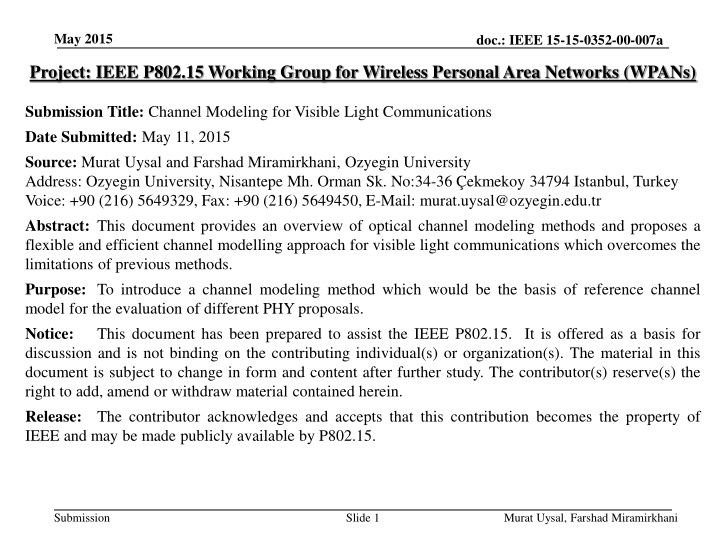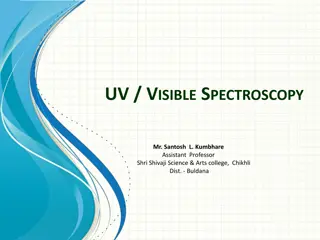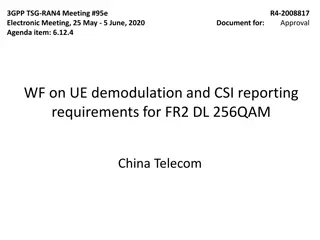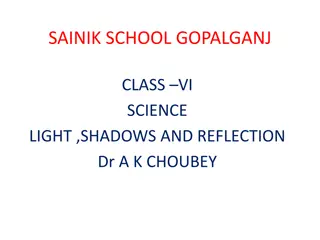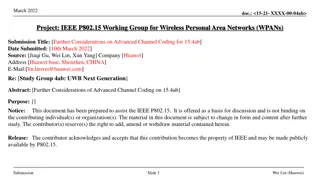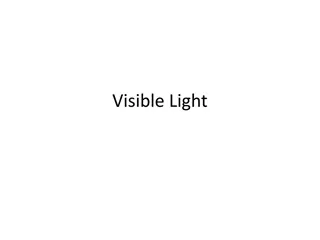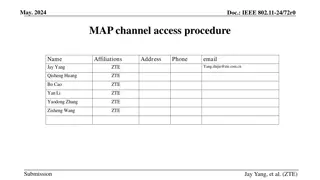Channel Modeling for Visible Light Communications: Overview and Proposed Methodology
This document presents a comprehensive overview of optical channel modeling methods for visible light communications, proposing a new approach to address limitations in existing methods. It emphasizes the importance of accurate channel models for evaluating physical layer proposals in VLC systems.
Download Presentation

Please find below an Image/Link to download the presentation.
The content on the website is provided AS IS for your information and personal use only. It may not be sold, licensed, or shared on other websites without obtaining consent from the author.If you encounter any issues during the download, it is possible that the publisher has removed the file from their server.
You are allowed to download the files provided on this website for personal or commercial use, subject to the condition that they are used lawfully. All files are the property of their respective owners.
The content on the website is provided AS IS for your information and personal use only. It may not be sold, licensed, or shared on other websites without obtaining consent from the author.
E N D
Presentation Transcript
May 2015 doc.: IEEE 15-15-0352-00-007a Project: IEEE P802.15 Working Group for Wireless Personal Area Networks (WPANs) Submission Title: Channel Modeling for Visible Light Communications Date Submitted: May 11, 2015 Source: Murat Uysal and Farshad Miramirkhani, Ozyegin University Address: Ozyegin University, Nisantepe Mh. Orman Sk. No:34-36 ekmekoy 34794 Istanbul, Turkey Voice: +90 (216) 5649329, Fax: +90 (216) 5649450, E-Mail: murat.uysal@ozyegin.edu.tr Abstract: This document provides an overview of optical channel modeling methods and proposes a flexible and efficient channel modelling approach for visible light communications which overcomes the limitations of previous methods. Purpose: To introduce a channel modeling method which would be the basis of reference channel model for the evaluation of different PHY proposals. Notice: This document has been prepared to assist the IEEE P802.15. It is offered as a basis for discussion and is not binding on the contributing individual(s) or organization(s). The material in this document is subject to change in form and content after further study. The contributor(s) reserve(s) the right to add, amend or withdraw material contained herein. Release: The contributor acknowledges and accepts that this contribution becomes the property of IEEE and may be made publicly available by P802.15. Submission Slide 1 Murat Uysal, Farshad Miramirkhani
May 2015 doc.: IEEE 15-15-0352-00-007a Channel Modeling For Visible Light Communications Submission Slide 2 Murat Uysal, Farshad Miramirkhani
May 2015 Outline doc.: IEEE 15-15-0352-00-007a oMotivation Overview of Optical Channel Modeling Methods Existing Works on VLC Channel Modeling o Proposed Methodology for VLC Channel Modeling o Channel Impulse Response Results CIR Results (Purely Diffuse) CIR Results (Mostly Specular ) CIR Results (Mixed) Comparison with existing results o Conclusions Submission Slide 3 Murat Uysal, Farshad Miramirkhani
May 2015 doc.: IEEE 15-15-0352-00-007a Motivation o Growing literature on VLC o Due to lack of proper channel models, infrared (IR) channel models are commonly used for the performance evaluation of VLC systems o VL and IR bands exhibit different characteristics An IR source can be approximated as a monochromatic emitter A white light LED source is inherently wideband (380-780nm). This calls for the inclusion of wavelength-dependent channel in VLC channel modeling. In IR band, the reflectance of materials is modeled as a constant. The reflectance of materials in the visible spectrum should be taken into consideration due to the wideband nature of VLC link. This necessitates the development of dedicated VLC channel models. Submission Slide 4 Murat Uysal, Farshad Miramirkhani
May 2015 doc.: IEEE 15-15-0352-00-007a Overview of Channel Modeling Methods o Recursive Methods o Monte Carlo Ray Tracing o Other Approaches Submission Slide 5 Murat Uysal, Farshad Miramirkhani
May 2015 doc.: IEEE 15-15-0352-00-007a Recursive Methods o Barry s Method [1] Discretize room surfaces (i.e., walls, floor, ceiling) into small cells Emit single ray from the source and track the ray s bounces until it reaches detector For each reflection, calculate the power and delay (i.e., CIR for that specific reflection) Overall CIR obtained as an infinite summation of CIRs for all reflections (in practice, truncated to a finite value) Underlying assumption: Empty Room o DUSTIN Algorithm [2] Modified recursive method for faster computation of CIR o Iterative Site-Based Method [3] Modified recursive method for a complex environment (i.e., with objects) [1] J. R. Barry, J. M. Kahn, W. J. Krause, E. A. Lee, and D. G. Messerschmitt, Simulation of multipath impulse response for wireless optical channels, IEEE J. Sel. Areas Commun., 11, 367 379, 1993. [2] F. J. Lopez-Hermandez, and M. J. Betancor, DUSTIN: Algorithm for calculation of impulse response on IR wireless indoor channels, IEEE Electronics Lett., vol. 33, no. 21, pp. 1804,1806, Oct 1997. [3] J.B. Carruthers, and P. Kannan, Iterative site-based modeling for wireless infrared channels, IEEE Trans. Antennas Propag., vol. 50, no. 5, pp. 759,765, May 2002. Submission Slide 6 Murat Uysal, Farshad Miramirkhani
May 2015 doc.: IEEE 15-15-0352-00-007a Monte Carlo Ray Tracing o Monte Carlo Ray Tracing [4], [5], [6] methods involve Discretization of room surfaces (i.e., walls, floors, ceiling) into small cells Ray generation based on a given statistical distribution (distribution type depends on the source) Track each ray until it reaches detector and calculate the detected power and associated delay [4] F.J. Lopez-Hernandez, R. Perez-Jimeniz, and A. Santamaria, Monte Carlo calculation of impulse response on diffuse IR wireless indoor channels, IEEE Electronics Lett., vol. 34, no. 12, pp. 1260,1262, Jun 1998. [5] F.J. Lopez-Hernandez, R. Perez-Jimenez, and A. Santamaria, Modified Monte Carlo scheme for high-efficiency simulation of the impulse response on diffuse IR wireless indoor channels, IEEE Electronics Lett., vol. 34, no. 19, pp. 1819,1820, Sep 1998. [6] F.J. Lopez-Hernandez, R. Perez-Jimenez, A. Santamaria, Ray tracing algorithms for fast calculation of the channel impulse response on diffuse IR wireless indoor channels, Opt. Eng. 39(10), 2775-2780, Oct 2000. Submission Slide 7 Murat Uysal, Farshad Miramirkhani
May 2015 doc.: IEEE 15-15-0352-00-007a Other Approaches oCeiling Bounce Model [7] Underlying assumptions: Source towards the ceiling and co-located with the detector Closed form for path loss and RMS delay spread Closed form expression for CIR [7] J. B. Carruthers, and J. M. Kahn, Modelling of non-directed wireless infrared channels, IEEE Trans. Commun., 45, 1260 1268, 1997. o Curve Fitting [8], [9] Curve fitting on measurement data Closed form expressions for RMS delay spread and mean excess delay spread [8] R. Perez-Jimenez, J. Berges, and M.J. Betancor, Statistical model for the impulse response on infrared indoor diffuse channels, IEEE Electronics Lett., vol. 33, no. 15, pp. 1298,1300, Jul 1997. [9] R. Perez-Jimenez, V.M. Melian, and M.J. Betancor, Analysis of multipath impulse response of diffuse and quasi-diffuse optical links for IR-WLAN, Proceedings of the Fourteenth Annual Joint Conference of the IEEE Computer and Communications Societies, vol. 2, pp. 924,930, Apr 1995. Submission Slide 8 Murat Uysal, Farshad Miramirkhani
May 2015 Existing Works on VLC Channel Modeling doc.: IEEE 15-15-0352-00-007a Method Modeling of Reflectance Number of Reflections Assumptions [10] Purely Lambertian Reflections Empty Room Monte Carlo Ray Tracing Fixed Reflectance Third Order [11] Purely Lambertian Reflections Empty Room Recursive (Barry s Method) Fixed Reflectance First Order [12] Purely Lambertian Reflections Empty Room Recursive (Barry s Method) Fixed Reflectance First Order [13] Purely Lambertian Reflections With Objects Recursive Averaged Reflectance Fourth Order (Iterative Site-Based) [14] Purely Lambertian Reflections Empty Room Recursive (Barry s Method) Wavelength Dependent Third Order [10] H. Chun, C. Chiang, and D. O Brien, Visible light communication using OLEDs: illumination and channel modeling, in Int. Workshop Opt. Wireless Commun., pp. 1 3, Oct. 2012. [11] H. Q. Nguyen, et al., A MATLAB-Based simulation program for indoor visible light communication system, CSNDSP 2010, pp. 537-540, July 2010. [12] T. Komine, and M. Nakagawa, Performance evaluation on visible-light wireless communication system using white LED lightings, in Proc. Ninth IEEE Symposium on Computers and Communications, vol. 1, pp. 258-263, 2004. [13] S. Long, M. A. Khalighi, M. Wolf, S. Bourennane, Z. Ghassemlooy, Channel characterization for indoor visible light communications, Optical Wireless Communications (IWOW), pp.75-79, Sept. 2014. [14] K. Lee, H. Park, and J. R. Barry, Indoor channel characteristics for visible light communications, IEEE Commun. Lett., vol. 15, no. 2, Feb 2011. Submission Slide 9 Murat Uysal, Farshad Miramirkhani
May 2015 Proposed Methodology for Channel Modeling doc.: IEEE 15-15-0352-00-007a CAD Objects (Furniture, etc) Channel DC Gain Characterization Channel Impulse Response (Matlab) Non- Light Source Specifications Mean Excess Delay Spread 3D Indoor Environment Modeling (Zemax) Sequential Ray-Tracing (Zemax) Coherence Bandwidth Detector Specifications RMS Delay Spread Material Reflectance Values E. Sarbazi, M. Uysal, M. Abdallah and K. Qaraqe, Indoor Channel Modelling and Characterization for Visible Light Communications , 16th International Conference on Transparent Optical Networks (ICTON), Graz, Austria, July 2014. F. Miramirkhani, M. Uysal, and E. Panayirci, Novel Channel Models For Visible Light Communications , SPIE Photonics West, San Francisco, California, United States, February 2015. Submission Slide 10 Murat Uysal, Farshad Miramirkhani
May 2015 doc.: IEEE 15-15-0352-00-007a 3D Indoor Environment Modeling o Creation of 3D indoor environment in Zemax involves the selection of Room size and shape CAD objects within the environment (furniture etc) Position and type of transmitters and receivers Type and properties of materials (walls, floor, ceiling, objects etc) Submission Slide 11 Murat Uysal, Farshad Miramirkhani
May 2015 doc.: IEEE 15-15-0352-00-007a Reflectance of Materials: IR vs VL Spectral Reflectance Spectral Reflectance 100 100 Aluminum [15] Floor [14] Plaster [14] Black Gloss Paint [15] Pine Wood [15] Plate Window Glass [15] Ceiling [14] 90 90 80 80 70 70 60 60 Reflectance (%) Reflectance (%) 50 50 40 40 Aluminum [15] Floor [14] Plaster [14] Black Gloss Paint [15] Pine Wood [15] Plate Window Glass [15] Ceiling [14] 30 30 20 20 10 10 0 0 400 450 500 550 600 650 700 780 800 820 840 860 880 900 920 940 960 980 Wavelength (nm) Wavelength (nm) o Reflectance is highly dependent on wavelenght in VL band. o Table coating feature in Zemax allows defining the wavelength dependent reflectance of surface coating for each material. [14] K. Lee, H. Park, and J. R. Barry, Indoor channel characteristics for visible light communications, IEEE Commun. Lett., vol. 15, no. 2, Feb 2011. [15] ASTER Spectral Library - Version 2.0, [Online]. Available at: http://speclib.jpl.nasa.gov. Submission Slide 12 Murat Uysal, Farshad Miramirkhani
May 2015 doc.: IEEE 15-15-0352-00-007a Specular vs. Diffuse Reflections Painted Wall Plastic Glass i =45 m=13 rd =0.001 Specular Reflections i =45 m=3 rd =0.55 Mixed Reflections i =45 m=0 rd =1 Purely Diffuse Reflections Phong s Equation Materials Comments ?? ? ( ) ( ) ( q 0 ) ( ) cosm P q q i r r q q , = cos + 1 - - Painted Wall 1 0 Purely Diffuse d 0 d 0 i Glass 0.001 13 Specular i : Incident angle 0:Observation angle m : Directivity of specular components rd : Percentage of diffuse reflections (Defined as scatter fraction in Zemax) White Ceramic 0.06 1 Specular Formica 0.14 112 Mostly Specular Varnished Wood 0.30 97 Mixed Plastic 0.55 3 Mixed Submission Slide 13 Murat Uysal, Farshad Miramirkhani
May 2015 doc.: IEEE 15-15-0352-00-007a Specular vs. Diffuse Reflections Painted Wall Paint Paper Glass White Ceramic Varnished Wood Formica Plastic Painted Wall Paint Paper Glass White Ceramic Varnished Wood Formica Plastic 90 90 1 1 120 60 120 60 0.8 0.8 0.6 0.6 150 30 150 30 0.4 0.4 0.2 0.2 180 0 180 0 210 330 210 330 240 300 240 300 270 270 i =0 i =45 o The specular reflections depend on the incident angle ( i) while the diffuse reflections are independent from incident angle. o Proper choice of scatter fraction (SF) and number of rays for diffuse reflections (NR) allows the definition of the specular/diffuse property of material in Zemax. Submission Slide 14 Murat Uysal, Farshad Miramirkhani
May 2015 doc.: IEEE 15-15-0352-00-007a Sources and Detectors o We can select commercially available source brands in Zemax Cree Inc., OSRAM AG, OPTO Diode Corp., Philips Lighting, Vishay Intertechnology, Panasonic Corporation, StockerYale Relative Radiant Power of Source Emission Pattern of Source TSA Vishay Intertechnology MC-E Cree Inc. o Detector Rectangle: Records and displays the power of each ray that reaches to the detector. Submission Slide 15 Murat Uysal, Farshad Miramirkhani
May 2015 doc.: IEEE 15-15-0352-00-007a Ray Tracing in Zemax o Based on Monte Carlo Ray Tracing o Sobol sampling is used for speeding up ray tracing o The Zemax non-sequential ray-tracing tool generates an output file, which includes all the data about rays such as the detected power and path lengths for each ray. o The data from Zemax output file is imported to MATLAB and using these information, the CIR is expressed as Pi = the power of the ith ray i = the propagation time of the ith ray (t) = the Dirac delta function Nr = the number of rays received at the detector Submission Slide 16 Murat Uysal, Farshad Miramirkhani
May 2015 doc.: IEEE 15-15-0352-00-007a Characterization of CIR Channel Parameters Definition Channel DC Gain ( ) h t dt = H 0 - () = t h t dt 0 t Mean Excess Delay Spread 0 () h t dt 0 2 ( ) ( ) h t dt = - t t 0 RMS Delay Spread 0 t RMS ( ) h t dt 0 Frequency Correlation Function ( ) ( ) h t e = - 2 D j p ft D H f dt - Coherence Bandwidth (Correlation level of 0.9) ( ) ( ) = min D suchthat D = 0.9 B f H f 0.9 Channel Transfer Function ( ) ( ) h t e = - 2 j p ft H f dt - Submission Slide 17 Murat Uysal, Farshad Miramirkhani
May 2015 doc.: IEEE 15-15-0352-00-007a Simulation Parameters Size of room Time resolution ( ) Number of lighting Number of chips per each lighting Power of each chip Lighting positions PD position View angle of lighting FOV of PD Area of PD Materials 5 m 5 m 3 m 0.2 ns 4 100 0.45 W D t (1.5,1.5,3) (1.5,3.5,3) (3.5,1.5,3) (3.5,3.5,3) (0.5, 1, 0) 120 85 1 cm2 Plaster (Walls) + Floor + Ceiling (see p13 for reflectance values) A: Purely Diffuse Reflections SF=1 NR=7 B: Mostly Specular Reflections SF=0.2 NR=7 C: Mixed Reflections SF=0.5 NR=7 Submission Slide 18 Murat Uysal, Farshad Miramirkhani
May 2015 3D Environment doc.: IEEE 15-15-0352-00-007a 10 10 LED Chips S2 S3 LED Chip MC-E Cree Inc. S4 S1 0.6 m Emission Pattern of Source 3 m OWC terminal 5 m Submission Slide 19 Murat Uysal, Farshad Miramirkhani
May 2015 doc.: IEEE 15-15-0352-00-007a CIR Results (ScenarioA: Purely Diffuse) o Assumption: Purely Diffuse Reflections SF=1 x 10-5 k=0 Proposed Approach 3.5 3 2.5 Power (Watt) 2 1.5 1 0.5 0 0 5 10 15 20 25 30 35 40 45 50 Time (ns) o In this figure, three peaks exist which are related to 4 LED lightings. The largest one corresponds to the nearest LED (S2) and the second one is related to two LEDs (S1 and S3) which are at the same distance from the photodetector and the last one is related to the farther LED (S4). Submission Slide 20 Murat Uysal, Farshad Miramirkhani
May 2015 doc.: IEEE 15-15-0352-00-007a Effect of Higher Order Reflections -1 ( ) t (1) h ( ) t (0) h 4x 10-5 -5 x 10 k=0 Proposed Approach 3.5 3.5 x 10-6 3 3 2 2.5 2.5 Power (Watt) Power (Watt) 1.5 2 2 1 1.5 1.5 0.5 1 1 0 0 10 20 30 0.5 0.5 0 0 0 5 10 15 20 25 30 35 40 45 50 0 5 10 15 20 25 30 35 40 45 50 Time (ns) Time (ns) x 10-5 o First order reflections contribute to increase the amplitude of zero order reflections. o The delay spread also increases by first order reflections. k=1 Proposed Approach 3.5 3 2.5 Power (Watt) 2 1.5 1 0.5 0 0 5 10 15 20 25 30 35 40 45 50 Time (ns) Submission Slide 21 Murat Uysal, Farshad Miramirkhani
May 2015 doc.: IEEE 15-15-0352-00-007a Effect of Higher Order Reflections -2 ( ) t ( ) t (2) h (0) ( ) t h (1) h 4x 10-5 4x 10-5 -5 x 10 k=0 Proposed Approach 3.5 3.5 3.5 2.5x 10-6 x 10-6 3 3 3 2 2 2.5 2.5 2.5 Power (Watt) Power (Watt) Power (Watt) 1.5 1.5 2 2 2 1 1 1.5 1.5 1.5 0.5 0.5 1 1 1 0 0 0 10 20 30 40 50 0 10 20 30 0.5 0.5 0.5 0 0 5 10 15 20 25 30 35 40 45 50 0 0 0 5 10 15 20 25 30 35 40 45 50 0 5 10 15 20 25 30 35 40 45 50 Time (ns) Time (ns) Time (ns) x 10-5 o Second order reflections slightly increases the amplitude of zero order reflections but effectively increases the delay spread of CIR. k=2 Proposed Approach 3.5 3 2.5 Power (Watt) 2 1.5 1 0.5 0 0 5 10 15 20 25 30 35 40 45 Time (ns) Submission Slide 22 Murat Uysal, Farshad Miramirkhani
May 2015 doc.: IEEE 15-15-0352-00-007a Comparison with Recursive Method x 10-5 k=3 [14] k=3 Proposed Approach 4 3.5 3 Power (Watt) 2.5 2 1.5 1 0.5 0 0 5 10 15 20 25 30 35 40 45 Time (ns) OWC terminal o The CIR is nearly the same as recursive method [14] for purely diffuse reflections and Lambertian source. o Unlike [14], our method works for any type of source o For other environments (specular, mixed) where [14] does not work, we can efficiently obtain CIRs [14] K. Lee, H. Park, and J. R. Barry, Indoor channel characteristics for visible light communications, IEEE Commun. Lett., vol. 15, no. 2, Feb 2011. Submission Slide 23 Murat Uysal, Farshad Miramirkhani
May 2015 doc.: IEEE 15-15-0352-00-007a Channel Characteristics (Purely Diffuse) 17.5 t0 tRMS 10 (ns) (ns) k H 17 9 0 Mean Excess Delay Spread ( 0 (ns)) 16.5 RMS Delay Spread ( RMS (ns)) 0 1 2 3 4 5 6 7 8 12.58 13.53 15.59 17.26 17.42 17.42 17.42 17.42 17.42 2.10 3.33 6.60 8.95 9.25 9.25 9.26 9.26 9.26 4.825 10-5 6.030 10-5 7.068 10-5 7.673 10-5 7.714 10-5 7.714 10-5 7.714 10-5 7.714 10-5 7.714 10-5 8 16 7 15.5 15 6 14.5 5 14 4 13.5 3 13 12.5 2 0 1 2 3 4 5 6 7 8 0 1 2 3 4 5 6 7 8 Number of Reflections (k) Number of Reflections (k) Mean Excess Delay vs. Number of Reflections RMS Delay vs. Number of Reflections 8x 10-5 7.5 7 Channel DC Gain (H0) 6.5 6 5.5 5 4.5 0 1 2 3 4 5 6 7 8 Number of Reflections (k) Channel DC Gain vs. Number of Reflections o The RMS delay, mean excess delay and channel DC gain saturate after 4 reflections. Submission Slide 24 Murat Uysal, Farshad Miramirkhani
May 2015 CIR Results (Scenario B: Mostly Specular) o Assumption: Mostly Specular Reflections SF=0.2 doc.: IEEE 15-15-0352-00-007a 4x 10-5 k=3 [14] k=3 (Proposed Approach) 3.5 3 2.5 Power (Watt) 2 1.5 1 OWC terminal 0.5 0 0 5 10 15 20 25 30 35 40 45 50 Time (ns) o The CIR for mostly specular case obviously differs from the CIR obtained for diffuse case. Submission Slide 25 Murat Uysal, Farshad Miramirkhani
May 2015 Channel Characteristics (Mostly Specular) doc.: IEEE 15-15-0352-00-007a t0 tRMS (ns) (ns) k H 10 18 0 9 0 1 2 3 4 5 6 7 8 9 12.365 13.854 15.241 16.469 17.079 17.444 17.643 17.744 17.792 17.816 17.818 17.821 17.821 17.821 17.821 1.945 3.454 5.376 7.124 8.077 8.783 9.227 9.491 9.638 9.721 9.733 9.744 9.744 9.745 9.745 4.190 10-5 7.406 10-5 8.602 10-5 9.198 10-5 9.433 10-5 9.538 10-5 9.585 10-5 9.605 10-5 9.612 10-5 9.616 10-5 9.616 10-5 9.616 10-5 9.616 10-5 9.616 10-5 9.616 10-5 Mean Excess Delay Spread ( 0 (ns)) 17 RMS DElay Spread ( RMS (ns)) 8 7 16 6 15 5 4 14 3 13 2 1 12 0 2 4 6 8 10 12 14 0 2 4 6 8 10 12 14 Number of Reflections (k) Number of Reflections (k) RMS Delay vs. Number of Reflections Mean Excess Delay vs. Number of Reflections -5 10x 10 9 Channel DC Gain (H0) 8 10 11 12 13 7 6 5 4 0 2 4 6 8 10 12 14 Number of Reflections (k) OWC terminal 14 Channel DC Gain vs. Number of Reflections o The RMS delay, mean excess delay and channel DC gain saturate after 7 reflections. o The saturation level of mostlyspecular scenario is higher than the purely diffuse Submission Slide 26 Murat Uysal, Farshad Miramirkhani
May 2015 doc.: IEEE 15-15-0352-00-007a CIR Results (Scenario C: Mixed) o Assumption: Mixed Reflections SF=0.5 x 10-5 k=3 [14] k=3 (Proposed Approach) 4 3.5 3 Power (Watt) 2.5 2 1.5 1 0.5 0 0 5 10 15 20 25 30 35 40 45 50 Time (ns) o The CIR for mixed case differs from the CIR obtained for diffuse case. In comparison to the mostly specular case, it exhibits more smooth characteristics. Submission Slide 27 Murat Uysal, Farshad Miramirkhani
May 2015 doc.: IEEE 15-15-0352-00-007a Channel Characteristics (Mixed) t0 tRMS 6 (ns) (ns) 15.5 k H 5.5 0 Mean Excess Delay Spread ( 0 (ns)) 15 5 0 1 2 3 4 5 6 RMS Delay Spread ( RMS (ns)) 12.44 13.88 14.76 15.05 15.11 15.11 15.11 1.98 3.52 4.93 5.49 5.61 5.61 5.61 4.534 10-5 7.387 10-5 8.063 10-5 8.193 10-5 8.209 10-5 8.210 10-5 8.210 10-5 14.5 4.5 14 4 3.5 13.5 3 13 2.5 12.5 2 12 1.5 0 1 2 3 4 5 6 0 1 2 Number of Reflections (k) 3 4 5 6 Number of Reflections (k) Mean Excess Delay vs. Number of Reflections RMS Delay vs. Number of Reflections 8.5x 10-5 8 7.5 Channel DC Gain (H0) 7 6.5 6 5.5 OWC terminal 5 4.5 0 1 2 Number of Reflections (k) 3 4 5 6 Channel DC Gain vs. Number of Reflections o The RMS delay, mean excess delay and channel DC gain saturate after 4 reflections. Submission Slide 28 Murat Uysal, Farshad Miramirkhani
May 2015 doc.: IEEE 15-15-0352-00-007a Conclusions o Provided an overview of optical channel modeling approaches o Proposed a flexible and efficient method for realistic VLC channel modeling Wavelength dependency Realistic sources Effect of objects and materials o Presented some initial results for a room size of 5m x 5m x 3m assuming diffuse, mostly specular and mixed conditions For diffuse case, we are able to reproduce the existing results in [14] using the same assumption of Lambertian source Unlike [14], our method works for any type of source For other environments (specular, mixed) where [14] does not work, we can efficiently obtain CIRs Submission Slide 29 Murat Uysal, Farshad Miramirkhani
May 2015 Future Plan doc.: IEEE 15-15-0352-00-007a o Based on the TG recommendations, we plan to obtain CIRs for the specified environments and make available as .m files for public use Submission Slide 30 Murat Uysal, Farshad Miramirkhani
May 2015 Acknowledgments doc.: IEEE 15-15-0352-00-007a This work is supported in part by the EU COSTAction IC1101 OPTICWISE. Submission Slide 31 Murat Uysal, Farshad Miramirkhani
